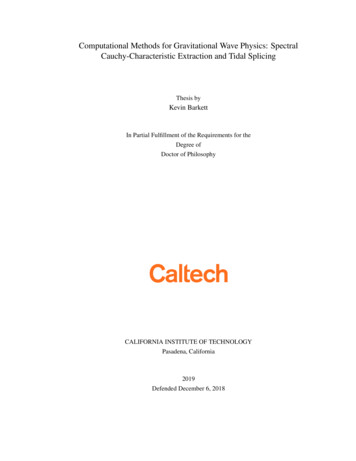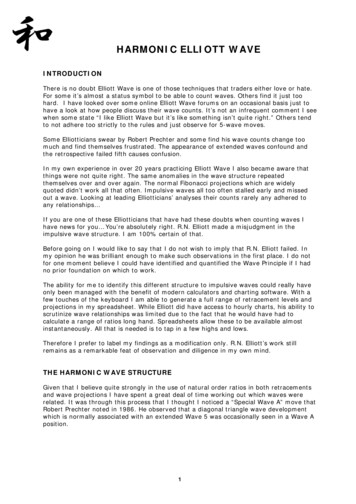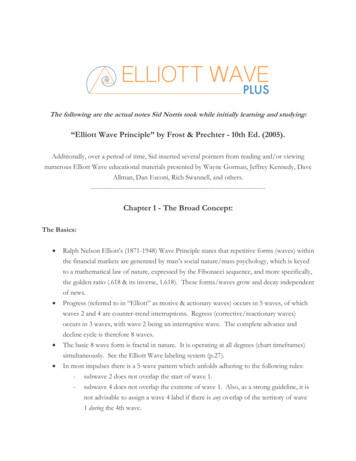
Transcription
Computational Methods for Gravitational Wave Physics: SpectralCauchy-Characteristic Extraction and Tidal SplicingThesis byKevin BarkettIn Partial Fulfillment of the Requirements for theDegree ofDoctor of PhilosophyCALIFORNIA INSTITUTE OF TECHNOLOGYPasadena, California2019Defended December 6, 2018
iic 2019Kevin BarkettORCID: 0000-0001-8230-4363All rights reserved
iiiACKNOWLEDGEMENTSAn undertaking of this size is not possible without the support and assistance provided by the manywonderful and fantastic people in my life:To my loving parents, for having my back through all of these long years since I was a wee littlelad. After nearly years, I’m finally getting out of school and moving into the real world!To Mark Scheel and Yanbei Chen for advising me over these many years, putting up with the slowplod through these projects, and for all of the useful tools and skills I have learned.To Jonathan, Vijay, Masha, and Matt G., and all of the other NR peers I’ve chatted with, for all ofthe nerdy, science discussionsTo the Friday Night Dinner group, for the years of constant fun and turmoil as we horribly botchedour way through a couple of campaignsTo Carla Corbit and Margo Miller, for all of the great times I have had working together with youduring the practices, and especially during the fencing tournaments.To all the crazy kids on the Caltech fencing team, for making practices and tournaments such fun tobe a part of.To JoAnn Boyd, for all the goofy faces, terrible (amazing) puns, and timely procrasti-chats.To Sherwood, Jonas, Mike, Matt O., Denise, and all of the other cool cats on 3rd floor Cahill, for allof the fun moments between working hours.To Sarah Gossan, for always bringing glam, glitter and cheer to the office, as well as a touch of thatquintessentially British flair.To John, Yeou, Mary, Steven, Andrew, Cameron, and all my buddies from before Caltech who haveput up with my weirdness longer than most.To Nicole Crione and all of the wonderful people I’ve met at her creative writing workshops overthe past couple years.To all of my other peers, collaborators, friends and relatives who’ve helped me on my journey.And last (and least?) to that small bunch of obnoxious people I am legally obligated to recognize asmy younger siblings: Guinevere, Patrick, Nicholas, Jacob, Eric, and Zachary (that’s right, I went inreverse order for once). Thanks for putting up with your older brother; love y’all!
ivABSTRACTAs the aLIGO and Virgo detectors continue to improve their sensitivity for observing gravitationalwaves from merging compact binaries, they will require ever more precise theoretical predictionsto extract a detailed understanding of the physics governing these merging systems. This thesis discusses advancements within computing the gravitational waveforms along two avenues of research:the continued development of a spectral Cauchy-Characteristic Extraction (CCE) code and the presentation of a novel method called ‘Tidal Splicing’ for generating waveforms for binary neutron star(BNS), black hole-neutron star (BHNS), and even Beyond GR systems.Due to the finite extents of typical 3 1 simulations of merging binaries, the waveforms they generate can suffer from near-zone effects and lingering gauge ambiguities. CCE was developed in orderevolve radiating gravitational waves as they propagate outward to future null infinity, allowing studies connecting the dynamical spacetime of binary evolutions to effects seen by distant observers,such as superkicks, and angluar and linear momentum fluxes. A recent spectral version of CCEshowed promising improvements in accuracy and efficiency over the older finite-differencing code,PittNull. However, lingering issues with the numerics and implementation of the theory preventedit from wide spread use. We detail the developments updated its initial release and demonstrate theenhancement in accuracy they yield beyond the capabilities of PittNull.The method of Tidal Splicing enhances the inexpensive Post-Newtonian (PN) tidal corrections withBBH waveforms from numerical simulations to generate waveforms corresponding to inpsiralingBNS or BHNS systems. This leverages the accuracy of numerical BBH waveforms to effectivelyreplace the corresponding unknown PN terms. In addition, by picking individual terms in the PNtidal expansions to include, then comparing with existing numerical simulations, we are able toprobe the significance of each contribution to the total difference in evolution between BBH andBNS or BHNS inspirals. We also demonstrate how the splicing concepts used for tidal effects canextended in order to model waveforms with corrections according to theories beyond GR using anexample case of a resonating ultra-compact object.
vPUBLISHED CONTENT AND CONTRIBUTIONSBarkett, K. and Scheel, M. A. and Szilágyi B. (2019). “Spectral Cauchy-Characteristic Extractionof gravitational wave news”. In Preparation.K.B. participated in the conception of the project, improving the numerical methods, performing the tests of the code, and writing the manuscriptBarkett, K. and Scheel, M. A., et al. (2016). “Gravitational waveforms for neutron star binaries from binary black hole simulations”. In: Phys. Rev. D. 93(4):044064, Feb 2016. doi:10.1103/PhysRevD.93.044064)K.B. participated in the conception of the project, deriving the underlying theory, performingthe comparisons and analysis, and writing the manuscript.Barkett, K. and Chen Y. and Scheel, M. A. and Varma V. (2019). “Generating gravitational waveforms for binaries with neutron stars using Tidal Splicing”. In Preparation.K.B. participated in the conception of the project, expanding the analytic expressions, extending the model, performing the comparisons and analysis of the waveforms, and writing themanuscriptBarkett, K. and Chen Y. (2019). “Computing gravitational waves beyond GR with splicing methods”. In Preparation.K.B. participated in the conception of the project, deriving the analytic expressions, comparingthe computed waveforms, and writing the manuscript
viTABLE OF CONTENTSAcknowledgements . . . . . . . . . . . . . . . . . . . . . . .Abstract . . . . . . . . . . . . . . . . . . . . . . . . . . . . .Published Content and Contributions . . . . . . . . . . . . . .Table of Contents . . . . . . . . . . . . . . . . . . . . . . . .List of Illustrations . . . . . . . . . . . . . . . . . . . . . . .List of Tables . . . . . . . . . . . . . . . . . . . . . . . . . .Chapter I: Introduction . . . . . . . . . . . . . . . . . . . . .Chapter II: Spectral Cauchy-Characteristic Extraction . . . . .2.1 Introduction . . . . . . . . . . . . . . . . . . . . . .2.2 Summary of characteristic formulation . . . . . . . .2.3 Inner Boundary Formalism . . . . . . . . . . . . . .2.4 Volume Evolution . . . . . . . . . . . . . . . . . . .2.5 Scri Extraction . . . . . . . . . . . . . . . . . . . . .2.6 Code Tests . . . . . . . . . . . . . . . . . . . . . . .2.7 Appendicies . . . . . . . . . . . . . . . . . . . . . .Chapter III: Introduction to Tidal Splicing . . . . . . . . . . .3.1 Preface . . . . . . . . . . . . . . . . . . . . . . . . .3.2 Introduction . . . . . . . . . . . . . . . . . . . . . .3.3 Methods . . . . . . . . . . . . . . . . . . . . . . . .3.4 Discussion . . . . . . . . . . . . . . . . . . . . . . .3.5 Acknowledgments . . . . . . . . . . . . . . . . . . .Chapter IV: Tidal Splicing for BHNS and BNS Systems . . . .4.1 Introduction . . . . . . . . . . . . . . . . . . . . . .4.2 Post-Newtonian Theory . . . . . . . . . . . . . . . .4.3 Expanding PN Tidal Corrections . . . . . . . . . . .4.4 Tidal Splicing . . . . . . . . . . . . . . . . . . . . .4.5 Results . . . . . . . . . . . . . . . . . . . . . . . . .4.6 Appendices . . . . . . . . . . . . . . . . . . . . . . .Chapter V: Resonanting Ultra-Compact Object Splicing Model5.1 Preface . . . . . . . . . . . . . . . . . . . . . . . . .5.2 Theoretical Framework . . . . . . . . . . . . . . . .5.3 Splicing Details . . . . . . . . . . . . . . . . . . . .5.4 Test Results . . . . . . . . . . . . . . . . . . . . . .Bibliography . . . . . . . . . . . . . . . . . . . . . . . . . 46875888888909194
viiLIST OF ILLUSTRATIONSNumberPage2.1Penrose diagram showing a typical CCE setup . . . . . . . . . . . . . . . . . . . .2.2The difference between the numerically evolved News function and the analytic solution for the linearized analytic test . . . . . . . . . . . . . . . . . . . . . . . . . .2.333The absolute values of the (2, 2) News modes from our SpEC code for differentcoordinate world tube radii r̆ in the Bouncing BH test . . . . . . . . . . . . . . . .2.732The absolute values of the News modes for the (3, 3) and (4, 4) for both the SpECand PittNull CCE codes in the Bouncing BH test . . . . . . . . . . . . . . . . . . .2.631The absolute values of the News modes for the (2, 2) and (2, 0) for both the SpECand PittNull CCE codes in the Bouncing BH test . . . . . . . . . . . . . . . . . . .2.529The difference between the numerically evolved News function and the analytic solution for the Teukolsky wave test . . . . . . . . . . . . . . . . . . . . . . . . . . .2.4636The absolute values of the News modes for the (2, 0) and (3, 0) for both the SpECand PittNull CCE codes in the gauge wave test . . . . . . . . . . . . . . . . . . . .383.1Phase difference between 1PN TaylorT4 tidal splicing and numerical waveforms . .453.2Phase difference between TaylorF2 tidal splicing and numerical waveforms . . . . .483.3Phase accumulation of 1PN Tidal effects . . . . . . . . . . . . . . . . . . . . . . .494.1The dynamical tides amplification κ as a function of orbital frequency . . . . . . .644.2Distribution of mismatches against the inspiral of the BHNS, q 1, nonspinningsimulation across sky locations. . . . . . . . . . . . . . . . . . . . . . . . . . . . .714.3Distribution of mismatches against the inspiral of all numerical simulations . . . . .724.4Distribution of mismatches with only (2, 2) mode against the inspiral of all numeri-5.1cal simulations with all modes . . . . . . . . . . . . . . . . . . . . . . . . . . . . .74Distinguishability of spliced waveform of resonanting ultra-compact object . . . . .92
viiiLIST OF TABLESNumberPage4.1List of parameters for numerical simulations considered . . . . . . . . . . . . . . .4.2Universal Relations relating the static dimensionless deformability to various other69dimensionless tidal parameters using Eq 4.70 . . . . . . . . . . . . . . . . . . . . .824.3Estimates of PN tidal self-cross terms, ω̄ISCO . . . . . . . . . . . . . . . . .864.4Estimates of PN tidal self-cross terms, ω̄test ω̄ISCO /5 . . . . . . . . . . . . . . . .866 3/2
1Chapter 1INTRODUCTIONOne prediction of Einstein’s theory of General Relativity (GR) is the existance of gravitationalwaves, ripples of gravity propagating at the speed of light which very subtly distort the space theypass through. Similar to how accelerating electrons and protons emit electromagnetic radiation, apair of massive objects orbiting around each other under the influence of gravity will emit gravitational radiation. The more massive the objects and the faster they are moving, the larger theseripples will be.When two objects are orbiting each other in a binary, the emission of gravitational radiation willcause the orbits to slowly decay and the objects to orbit closer to each other. As the orbit shrinks,they orbit about each other faster, leading to a greater emission of gravitational radiation. If thereare no other effects influencing the orbits, this process will continue, slowly accelerating the objectsin the binary closer to each other until they collide, merging into a single object. The gravitationalwaves will be largest when a pair of ultra dense objects are orbiting in close proximity to each other.Thus, the binaries which will generate the strongest gravitational waves will be those comprising ofeither a Black Holes (BH) or a Neutron Stars (NS) during the last, decaying orbits as they coalesceinto a single object.For most of the past century, gravitational waves even from colliding BHs or NSs were far too weakfor observatories on Earth to detect, as the source of those systems typically originate hundreds ofmillions or billions of light-years away. It has only been in the past few years, with the impressivedevelopments with the aLIGO [2] and Virgo [14] detectors, has the technology improved to the pointwhere these faint signals can be observed, opening a new window to peer at the rest of the universe.The first detection of colliding BHs, GW150914 [7] (named according to the date it was detected),heralded the start of gravitational wave astronomy. This direct detection of gravitational waves ledto the 2017 Nobel Prize in Physics. There have since been a number of additional observationsof the colliding BHs [6, 10–12], as well as a detection of colliding NSs, GW170817 [13]. As thedetectors push to ever more sensitive configurations, the number of expected gravitiational wavesignals they are expected to observe will only increase.The configuration of the orbiting binary, the mass of each BH or NS, how much they are rotatingabout their axis, and so forth, all imprint different signatures on the resulting signal pattern. Oneof the challenges facing these detectors is how to extract the signal of a passing gravitiational wavefrom the noise inherent within the detector. We may detect such a signal by comparing the observedsignal against a template bank of theoretical signals at various possible configurations, and findingwhich configurations best match the signal. From this, we can estimate the configuration of thebinary which generated the gravitiational waves. However, these estimates are only as good as the
2signals used to generate the template bank.The primary difficulty of computing the possible gravitational waves to populate the template bankis that there are no closed form solutions to describing the orbits of a binary evolving according toGR. As such, researchers employ other methods to compute the theoretical signals, from numericalsimulations to analytic approximants and calibrated models, each with their own advantages anddisadvantages.Numerical simulations are preferable, as they are the full calculation of the binary within GR usingcomputational techniques. Current simulations of these binaries employ a "3 1" decompostion,where they compute the Einstein equations across 3 spatial dimension at a single time slice, thenusing those results in order to advance the simulations forward to the next discrete time slice. Onelimitation of this formulation is that such simulations only extend to a compact spatial region aroundbinary and nowhere near the typically millions to billions of light-years of intervening distance between the binary and detectors on Earth. While there are a few methods for estimating the resultinggravitational waves from the outer edge of the simulations, they are not perfect and the particularway in which the simulation chooses its coordinates can affect them.These limitations led to the development of a method called Cauchy-Characteristic Extraction(CCE) [35, 36, 39], which can simulate how pattern of radiating gravitational waves propagateoutward to arbitrarily far distances. It does so by way of a "2 1 1" decomposition of the Einsteinequations, which evolves the spacetime along the trajectories of the gravitiational waves. Whilethis method does not work for the intense, dyanmical gravity near compact orbiting objects, CCEcan extract the results from the outer edge of the 3 1 simulation to compute the final signals whichwould be observable from Earth. This also means that we can use CCE in order to study howthe local GR physics connect to measurable quantities by distant observers, such as measuring theringdown [32], as well as kicks and fluxes of angular and linear momentum from merging binaries.While an older version of a finite-differencing CCE code has been available for use [21, 135, 136]it was only recently with the development of a spectral version of CCE which promised to befast enough for large scale use. Chapter 2 includes detailed discussion of the numerous changesand improvements made to this spectral CCE code since its initial implementation in [87–89]. Italso includes various tests of the code demonstrating its accuracy and efficiency in computing theradiated gravitational waves.Unfortunately, full 3 1 simulations are computationally expensive and this expense scales with thedifficulty of the object being simulated. While BHs are relatively smooth objects, where the simulations can excise most of the interior space behind the event horizon, NSs are made of extremelydense matter. The matter influences and is influenced by the binary’s orbit and thus alters gravitational wave signal. So while numerical developments allow current simulations of orbiting BHsto be run relatively efficiently, the behavior of the matter within the NSs drastically increases thesimulation cost. Currently, using numerical simulations for systems with NSs to populate templatebanks is computationally prohibitive.
3An alternative method of generating the signals from these binaries is analytic approximants whichare cheap to generate while the orbit is decaying. Within these approximations, the NSs are treatedas corrections to binaries comprised of only BHs. However, they are approximations so their accuracy worsens as the objects near collision. Ironically, it is the corrections corresponding to the BHonly system which are expected become inaccurate before the additional NS corrections fully manifest in the gravitational wave signal. In this sense, the analytic approximants for NSs in a binaryare limited by the relatively poor knowledge of the BHs.This particular dichotemy of relatively efficient simulations of BHs and cheap analytic correctionsfor NSs which gives rise to a hybrid method of generating gravitational wave signals for binarieswith NSs that I have innovated called ‘Tidal Splicing’. This method works by treating the signalfrom the numerical simulations as if it had been generated as a corrected analytic approximant.Then the analytic corrections for the NSs are added on top of the numerical results, generating a newsignal which approximates the orbital behavior as if the binary had been made of NSs originally.This also allows us to disentangle the contributions of individual effects, such as spinning NSsand dynamical tides, to the overall signal by tuning which effects we include when splicing thewaveform. Chapters 3 and 4 give a full description of the concepts behind this model and resultswhen compared with numerical simulations with NSs.There are also theoretical motivations for considering the case in which black holes are not perfectly‘black’, but instead are ultra-compact objects with surfaces just outside the event horizon. Whilesuch differences would be nearly imperceptible to electromagnetic observations, these objects wouldexhibit distinct inspiraling evolution from BHs or NSs, thus requiring additional work to model thepatterns of gravitational waves they emit. Chapter 5 will demonstrate how splicing methods providesthe potential for modeling such additional corrections to exotic objects in orbiting binaries.
4Chapter 2SPECTRAL CAUCHY-CHARACTERISTIC EXTRACTION2.1IntroductionThe discovery of GW150914 [7] heralded the beginning of gravitational wave astronomy. In thesubsequent years that detection has been followed up by a number of other signals observed frombinary black hole (BBH) mergers [6, 10–12], as well as from the merger of a binary neutron star(BNS) system [13]. As the aLIGO [2] and Virgo [14] detectors push to ever greater sensitivities, thenumber of expected observations will continue to grow.Extracting the signals from the noise involves matching the incoming data against a template bank oftheoretically expected waveforms generated across possible binary configurations. The efficacy ofextracting the configuration parameters (for instance, masses and spins of the binary components)from a given signal depends on the fidelity of the computed waveforms comprising the templatebank; this is because errors in the template bank will bias the estimated parameters. The onlyab initio method of generating accurate theoretical waveforms for merging BBH systems is vianumerical relativity: the numerical solution of the full Einstein equations on a computer. Othermethods of generating theoretical BBH waveforms, such as Effective One-Body solutions [53] andphenomenological models [101, 104], are calibrated to numerical relativity.One limitation of numerical relativity simulations is that they all rely on a Cauchy approach in whichthe spacetime is decomposed into a foliation of spacelike slices, and the solution marches from oneslice to the next. Such an approach can compute the solution to Einstein’s equations only in a regionof spacetime with finite spatial and temporal extents bounded around the compact objects, whereasthe gravitational radiation is defined at future null infinity I . Extracting the waveform signal fromthe simulations with these finite extents requires additional work.The most common method of extracting the gravitational radiation from a numerical relativity simulation is to compute quantities such as the Newman-Penrose scalar Ψ4 [119] or the Regge-Wheelerand Zerilli scalars [140] at some large but finite distance from the near zone (perhaps 100–1000M,where M is the total mass of the system), typically on coordinate spheres of constant coordinateradius r. Because these quantities or the methods of computing them include finite-radius effects,these quantities are computed on a series of shells at different radii r, fit to a polynomial in 1/r,and then extrapolated to infinity by reading off the 1/r coefficient of the polynomial [57]. As theextraction surfaces are shells of constant coordinate radii, the choice of gauge implemented in thesimulation can contaminate the resulting waveforms. Furthermore, if the shells are too close to theorbiting binary, the extrapolation procedure might not remove all of the near-zone effects.An alternative method for computing gravitational radiation in numerical relativity is to solve thefull Einstein equations in a domain that extends all the way to I , where gravitational waves can
5be measured. This can be done by rewriting Einstein’s equations using a characteristic formalism [54, 122, 139], in which the equations are solved on outgoing null surfaces that extend to I .This formalism chooses coordinates that correspond to distinct outward propagating null rays, so itfails in the dynamical, strong field regime at any location where outgoing null rays intersect (i.e.,caustics). Because of this, characteristic evolution is unable to evolve the near-field region of amerging binary system, so it cannot accomplish a BBH simulation on its own. However, it is possible to combine an interior numerical relativity code that solves the equations on Cauchy slices withan exterior characteristic code that solves them on null slices; this approach is known as CauchyCharacteristic Extraction (CCE). (See Fig. 2.1.)Specifically, CCE takes metric data known on a world tube Γ (thick red line in Fig. 2.1) that lieson or inside the boundary of a Cauchy evolution (red region), and treats it as inner boundary datafor a characteristic evolution outward along null slices (blue curves). Because the combined CCEsystem uses the full Einstein equations, it produces the correct solution at I , with the characteristicevolution properly resolving near-zone effects. The gravitational radiation is computed accordingto a particular inertial observer at I (green curve). This particular observer is related to any otherinertial observer by a single BMS transformation [139] (the group of Lorentz boosts, rotations,and supertranslations [138]), so up to this BMS transformation the waveform is independent of thegauge chosen by the Cauchy evolution.The first code to implement CCE was the PittNull code [35, 36, 39]. Since its initial implementationthere have been a number of improvements made, and the current iteration of that code utilizesstereographic angular coordinate patches, finite-differencing, and a null parallelogram scheme withfixed time steps for integrating in the null and time directions. Overall the code is second-orderconvergent with resolution [21, 135, 136]. Compared to waveforms computed from a Cauchy codeby evaluating Ψ4 at finite radii and extrapolating to r as described above, waveforms extractedvia CCE using PittNull were shown to better remove gauge effects and to better resolve the m 0memory modes [125, 134, 151].Currently, PittNull requires thousands of CPU-hours to compute a waveform at I given worldtubeoutput from a typical Cauchy BBH simulation at multiple resolutions [87]. While that cost is smallerthan the computational expense of the Cauchy simulation, it is still unwieldy, and is likely one reasonthat most Cauchy numerical-relativity codes do not use CCE despite the availability of PittNull.Because the metric in the characteristic region is smooth, the computational cost of characteristicevolution should be greatly reduced by using spectral methods instead of finite differencing. Such aspectral implementation of characteristic evolution has been introduced in the SpEC framework [87–89]. Their tests showed improved speed and accuracy over the finite-difference implementation ofPittNull [87, 88].Our work here describes improvements in accuracy, efficiency, and robustness to the code describedin [87–89]. In particular, we discuss an improved handling of the integration along the null slices, weclarify issues related to the particular choice of coordinates along the null slice, and we implement
6Figure 2.1: Penrose diagram showing a typical CCE setup. The metric is evolved using 3 1 methodsin the Cauchy region (shaded red) and with null methods in the characteristic region (shaded blue).The Cauchy and characteristic regions overlap. Curves of constant t or r̆, the Cauchy coordinates,are shown in red, and are shown as dashed curves outside the Cauchy region, where they extendto spatial infinity i 0 or future temporal infinity i . Null curves of constant u are shown in blue.Given data on an worldtube Γ (thick red curve) and on an initial null slice (thick blue curve), thecharacteristic evolution computes the full metric in the characteristic region. In Section 2.3 wedescribe the interface from Cauchy to Bondi coordinates on Γ. In Section 2.4 we describe thecharacteristic evolution. In Section 2.5 we discuss computing the News function at I (thick greencurve) and transforming it to coordinates corresponding to a free-falling observer.
7better handling of the inertial coordinates at I . We demonstrate through a series of analytic teststhat our version of CCE can compute waveforms with much lower computational cost than PittNull.We start with a brief summary of the Bondi metric and the null formulation of the Einstein equationsin Sec 2.2. A detailed explanation for how CCE works can be broken up into three distinct parts: theinner boundary formalism, the volume characteristic evolution, and the I extraction, which wedescribe in subsequent sections. Sec 2.3 describes the means by which the metric data known on aworld tube is converted into Bondi form to serve as the inner boundary values for the characteristicevolution system. Sec 2.4 discusses the process of evolving Einstein’s equations from the innerboundary to I . Sec 2.5 explains how to take the metric data computed on I and extract theBondi news function in the frame of an inertial observer at I . In Sec 2.6, we describe code testsand performance.Throughout this paper, indices with Greek letters (µ, ν, .) correspond to spacetime coordinates,lowercase Roman letters (i, j, .) to spatial coordinates, and capitalized Roman letters (A, B, .) toangular coordinates, and we choose a system of geometrized units (c G 1). For convenience,we have included a definitions key in appendix 2.7.2.2Summary of characteristic formulationIn the characteristic region (see Fig. 2.1), we adopt a coordinate system x µ (u,r, x A ), where uis the coordinate labeling the outgoing null cones, r is an areal radial coordinate, and x A are theangular coordinates. Note that a surface of constant (u, x A ) is an outgoing null ray parameterizedby r; for this reason we sometimes call r a “radinull” coordinate. The metric can then be expressedin the Bondi-Sachs form [54, 139], ds2 e2β (1 rW ) r 2 h AB U AU B du2 2e2β dudr 2r 2 h AB U B dudx A r 2 h AB dx A dx B ,(2.1)where W corresponds to the mass aspect, U A to the shift, β to the lapse, and h AB to the spherical2-metric. The quantity h AB has the same determinant as the unit sphere metric q AB , h AB q AB .An additional intermediate quantity, Q A , is defined to reduce the evolution equations to a series of1st order PDEs,Q A r 2 e 2β h AB U,rB .(2.2)Instead of expressing the metric in terms of tensorial objects, we employ a complex dyad so thatthe metric components can be computed as spin-weighted scalars, and each of these scalars canbe expanded in terms of Spin-Weighted Spherical Harmonics (SWSHes) of the app
To all the crazy kids on the Caltech fencing team, for making practices and tournaments such fun to be a part of. . sentation of a novel method called 'Tidal Splicing' for generating waveforms for binary neutron star (BNS), black hole-neutron star (BHNS), and even Beyond GR systems. . ing the tests of the code, and writing the .











